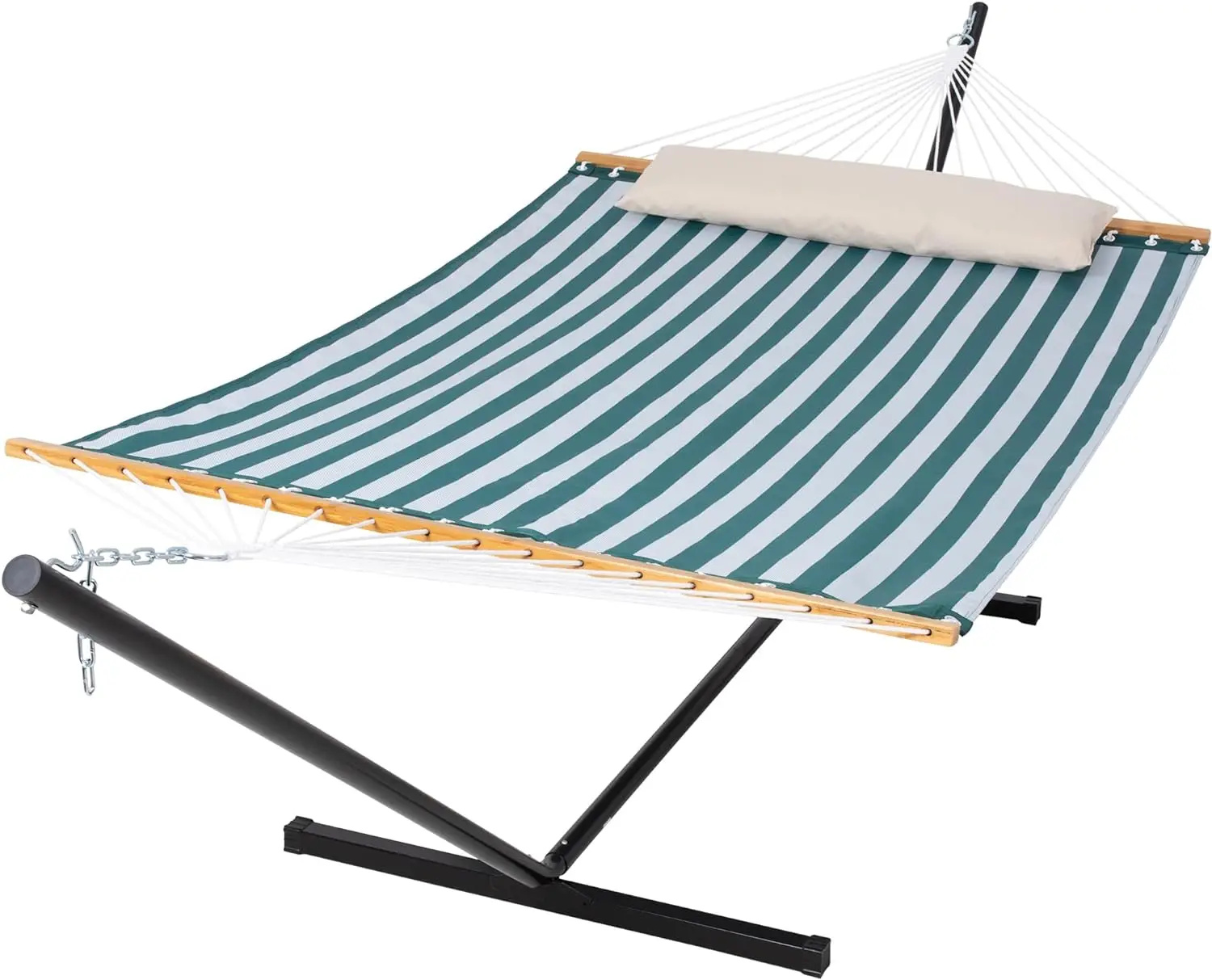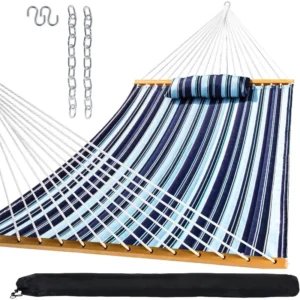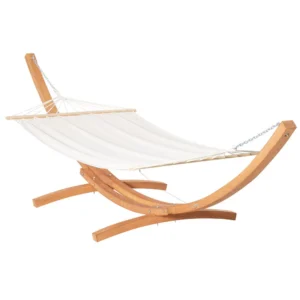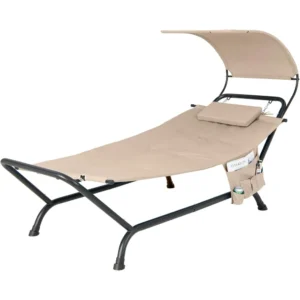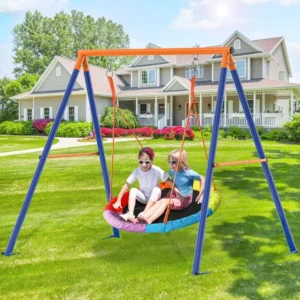Understanding Hammock Weight Capacity: The Basics
When shopping for a hammock, one of the most important specifications to consider is its weight capacity. This number tells you how much weight the hammock can safely support without risking damage or failure. But what does this rating actually mean?
Weight capacity for hammocks typically refers to static weight – the load a hammock can hold when you’re lying still. Dynamic weight, created when you’re getting in and out or swinging, puts significantly more stress on the hammock system.
Understanding proper hammock weight capacity guidelines is essential for several important reasons:
- Safety is paramount – exceeding limits can lead to unexpected failures and potential injury
- Longevity of your hammock depends on using it within specified parameters
- Proper weight distribution affects comfort and prevents premature wear
- Most warranties become void if weight limits are exceeded
Manufacturers determine these ratings through stress testing, material analysis, and applying safety factors to ensure reliable performance. Most standard hammocks have weight capacities ranging from 250-800 lbs (113-363 kg), but this can vary significantly based on design and materials.
It’s crucial to understand that a hammock is only as strong as its weakest component. Even if the fabric can theoretically hold 500 pounds, if the suspension system is rated for 300 pounds, that becomes your functional limit. Comprehensive understanding of hammock load capacity helps prevent dangerous situations and equipment failure.
Critical Factors That Determine a Hammock’s Weight Limit
Several key factors work together to determine how much weight your hammock can safely support. Each element contributes to the overall strength of the system.
Material Composition and Quality
The type, quality, and thickness of materials used in a hammock dramatically impact its weight capacity. High-denier nylon will generally support more weight than thin cotton. Premium materials with proper treatment and manufacturing processes result in stronger hammocks that maintain their integrity over time.
Construction Techniques and Craftsmanship
How a hammock is made matters just as much as what it’s made from. Quality stitching patterns, reinforced stress points, and proper edge finishing all contribute to higher weight capacity. A hammock with triple-stitched seams will typically outperform one with single stitching, even if made from identical materials.
Suspension System Strength
The hammock material vs weight capacity relationship is important, but equally critical is how that hammock connects to your anchor points. Ropes, straps, carabiners, and hardware must all meet or exceed the capacity of the hammock fabric itself. Many hammock failures occur not in the fabric but in these connection points.
Anchor Point Stability
Even the strongest hammock system will fail if attached to unstable anchor points. Whether you’re using trees, posts, or a dedicated hammock stand, these points must be capable of supporting more than your hammock’s rated weight capacity.
For users seeking exceptional strength and reliability, our collection of heavy-duty hammock sets provides options specifically engineered for higher weight capacities, with reinforced components throughout the entire system.
Material Matters: How Fabric Affects Weight Capacity
The fabric choice in a hammock is perhaps the most visible factor affecting weight capacity. Each material offers different benefits and limitations when it comes to strength.
Nylon Varieties
- Parachute Nylon: Lightweight and supportive, with capacities often between 300-400 lbs (136-181 kg)
- Ripstop Nylon: Features reinforcement threads that prevent tears from spreading, increasing durability
- Denier Rating: Higher numbers (like 210D vs 70D) indicate thicker, stronger fabric
Polyester Options
- More UV-resistant than nylon, maintaining strength longer in sunny conditions
- Less stretch than nylon, providing more stable support
- Often used in premium hammocks due to longevity and consistent performance
Traditional Materials
- Cotton: Classic comfort but generally supports less weight (typically 200-350 lbs/90-159 kg)
- Canvas/Duck Cloth: Heavier but extremely durable, with weight capacities often exceeding 450 lbs (204 kg)
Specialized Fabrics
- Aerial yoga hammocks use silk or nylon blends engineered for dynamic movement
- Marine-grade fabrics offer exceptional weather resistance for permanent outdoor installation
The weave pattern and thread count significantly impact a hammock’s fabric hammock weight capacity. Tighter weaves generally offer greater strength but may sacrifice some breathability. The trade-off between ultimate strength, comfort, weight, and portability leads to the wide variety of hammock designs available today.
Construction Techniques: Building for Maximum Support
Beyond materials, how a hammock is constructed plays a crucial role in determining its weight capacity. Premium hammocks employ specific techniques to maximize strength and durability.
Stitching Patterns and Quality
- Triple-stitched seams can support up to 50% more weight than single stitching
- Reinforced stress points at connection areas prevent fabric tearing
- Lock stitching provides superior durability compared to chain stitching
- Consistent, even stitching indicates quality manufacturing and reliable strength
End Connections
- Gathered ends with proper whipping distribute weight evenly across fabric
- Channel ends with wooden spreader bars create different weight distribution patterns
- Reinforced end loops with metal grommets provide exceptional strength at critical connection points
Edge Treatments
- Double-folded edges prevent fraying and add structural integrity
- Reinforced borders help maintain shape under load
- Edge binding tape adds strength while preventing stretching
Layer Count and Redundancy
- Multiple fabric layers provide significantly higher weight capacity
- Redundant suspension connection points offer safety backups
- Strategic reinforcement patches at high-stress areas extend lifespan
Quality control during manufacturing makes a tremendous difference in the final product’s strength. Hammocks that undergo rigorous testing and inspection typically offer more reliable weight capacity ratings and consistent performance over time.
Hammock Types and Their Typical Weight Capacities
Different hammock designs and styles come with varying weight capacities to suit different needs and users.
| Hammock Type | Typical Materials | Average Weight Capacity | Best Use Case |
|---|---|---|---|
| Single Camping | Nylon, Polyester | 250-400 lbs (113-181 kg) | Solo backpacking, lightweight travel |
| Double Camping | Reinforced Nylon | 400-500 lbs (181-227 kg) | Couples, larger individuals |
| Backyard Rope | Cotton, Polyester | 275-350 lbs (125-159 kg) | Casual relaxation |
| Brazilian | Cotton, Polyester blend | 330-450 lbs (150-204 kg) | Long-term comfort, home use |
| Mayan/Mexican | Cotton string | 330-550 lbs (150-249 kg) | Traditional design, warm weather |
| Spreader Bar | Quilted Cotton, Sunbrella | 275-450 lbs (125-204 kg) | Decorative, stable lying position |
| Chair Hammock | Reinforced Cotton/Poly | 250-300 lbs (113-136 kg) | Upright seating position |
| Expedition Grade | Military-grade Nylon | 500-800 lbs (227-363 kg) | Extreme conditions, heavy users |
The significant difference between single double hammock weight limits reflects their intended use. Single hammocks prioritize portability and lightweight design, while doubles offer more fabric and reinforcement for multiple users or larger individuals.
Our collection of double two-person hammock sets features designs specifically engineered to accommodate two adults safely and comfortably with appropriate weight capacity ratings.
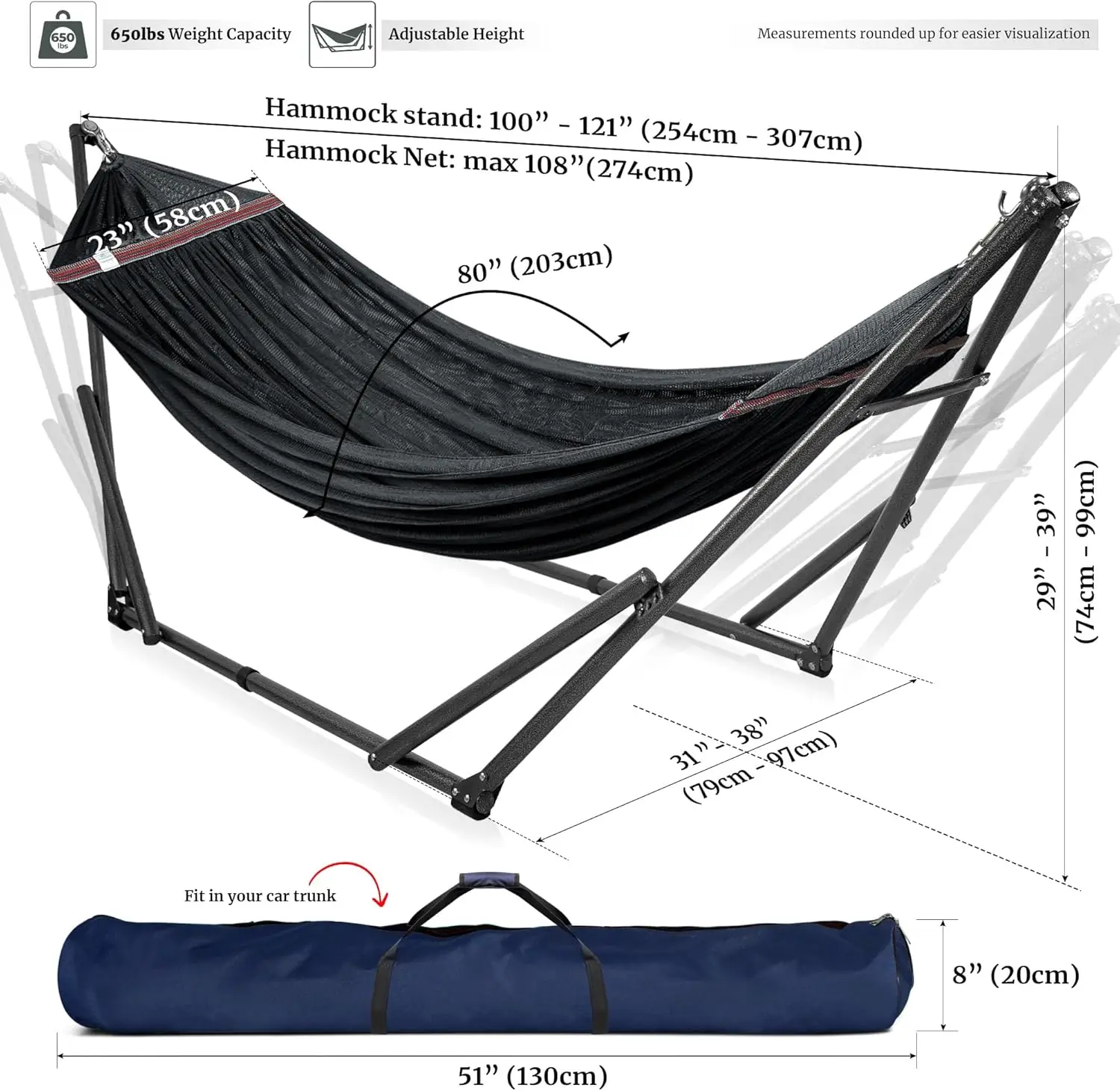
Suspension Systems: The Often Overlooked Component
While many people focus on the hammock fabric when considering weight capacity, the suspension system often represents the most vulnerable part of the entire setup. A failure here can be just as catastrophic as fabric tearing.
Strap and Webbing Options
- Polyester webbing (1-inch): Typically rated for 250-400 lbs (113-181 kg)
- Polyester webbing (2-inch): Can support 400-1500 lbs (181-680 kg)
- Nylon webbing: Stretches more than polyester but offers good strength
- Specialized materials like Dyneema: Extraordinary strength-to-weight ratio
Connection Hardware
- Aluminum carabiners: Lighter weight with capacities from 300-600 lbs (136-272 kg)
- Steel carabiners: Heavier but stronger at 500-2500 lbs (227-1134 kg)
- S-hooks: Generally weaker than carabiners, typically 200-400 lbs (90-181 kg)
- Steel rings: Excellent strength but require specific attachment methods
Common Failure Points
- Stitching where straps connect to hammock body
- Weak or improperly closed carabiners
- Friction wear at contact points with trees or stands
- Knots that reduce rope strength by 20-40%
For a reliable setup that eliminates many suspension concerns, our A-frame stand hammock sets provide engineered solutions with matched components rated for specific weight capacities.
Setting Up for Success: Proper Installation for Maximum Capacity
Even the strongest hammock won’t support its rated weight capacity if improperly installed. Correct setup is essential for safety and performance.
The ideal hanging angle for most hammocks is approximately 30 degrees from horizontal. This angle creates the optimal balance between comfort and stress distribution. Hanging too flat increases lateral forces that can exceed what the suspension system was designed to handle.
The distance between anchor points significantly impacts weight distribution. As a general rule:
1. Measure your hammock length
2. Add 2-3 feet (60-90 cm) to that measurement
3. Use this as your minimum distance between anchor points
Proper height is also crucial – too high increases fall risk, while too low may cause bottoming out. A hammock weight support guide suggests hanging the lowest point of your hammock about 18 inches (45 cm) above the ground.
Distributing your weight evenly across the hammock prevents dangerous pressure on any single point. Lying at a slight diagonal angle (about 10-15 degrees off-center) is the most effective way to flatten your position and distribute weight across more of the fabric.

Specialized Hammocks: Extra-Strong Options for Heavier Users
For individuals requiring higher weight capacities, specialized hammock options provide peace of mind and superior performance.
Heavy-duty camping hammocks designed specifically for larger users often feature:
* Reinforced triple-stitched seams throughout
* Higher denier ratings (often 210D or higher)
* Multiple fabric layers in high-stress areas
* Upgraded carabiners and hardware
* Weight capacities of 400-800 lbs (181-363 kg)
Double hammocks designed for couples incorporate:
* Wider dimensions for comfortable sharing
* Strengthened connection points to handle uneven weight distribution
* More robust suspension systems with redundant safety features
Commercial-grade options for resorts and rental properties offer exceptional durability with:
* Marine-grade, UV-resistant fabrics
* Weather-proof hardware components
* Capacities often exceeding 600 lbs (272 kg)
* Enhanced warranty coverage
For comprehensive information about suitable options, the ultimate guide hammocks heavier individuals provides detailed recommendations based on user weight, intended use, and durability requirements.
Our selection of portable hammocks stands includes options specifically rated for higher weight capacities while maintaining portability.
A-Frame Stand Hammock Sets, Swinging Hammock Chair Sets
$154.62 Select options This product has multiple variants. The options may be chosen on the product pageClassic Wooden Stand Hammock Sets, Heavy Duty Hammock Sets
$1,061.68 Select options This product has multiple variants. The options may be chosen on the product pageHammock Sets with Canopy, Heavy Duty Hammock Sets
$286.31 Select options This product has multiple variants. The options may be chosen on the product pageDouble / Two Person Hammock Sets, Rope Hammock Sets
Double Traditional Cotton Rope Hammock with Extension Chains – 450 lbs Capacity for Backyard & Patio$292.98 Select options This product has multiple variants. The options may be chosen on the product pageFolding Hammock Sets, Quick Setup Hammock Sets
Price range: $305.52 through $583.27 Select options This product has multiple variants. The options may be chosen on the product page
Safety First: Warning Signs and Regular Inspections
To maintain the weight capacity of your hammock over time, regular inspection and maintenance are essential.
Pre-Use Inspection Checklist
- Examine fabric for tears, fraying, or discoloration
- Check all seams for loose threads or separation
- Inspect suspension straps for wear, especially at connection points
- Verify carabiner gates close completely and lock securely
- Confirm anchor points remain solid and undamaged
Warning Signs That Require Immediate Attention
- Visible stretching or deformation of fabric when weighted
- Popping or creaking sounds when entering the hammock
- Frayed edges or loose threads around stress points
- Rust or corrosion on metal components
- Fading or brittleness from UV exposure
Environmental factors can significantly reduce a hammock’s weight capacity over time. Prolonged sun exposure can weaken nylon by up to 30%, while moisture can promote mildew and rot in natural fibers like cotton. Storing your hammock properly when not in use extends its functional lifespan and maintains its weight capacity.
Single vs. Double Hammocks: Understanding the Weight Difference
The distinction between single and double hammocks often causes confusion regarding weight capacity.
Double hammocks typically offer weight capacities between 400-500 lbs (181-227 kg), while singles usually support 250-400 lbs (113-181 kg). However, this doesn’t necessarily mean two adults can always safely use a double hammock, despite the name.
Weight distribution becomes critically important with two users. When sharing a hammock, bodies tend to roll toward the center, concentrating weight in one area rather than distributing it evenly across the fabric. This creates stress points that may exceed the hammock’s design parameters.
For comfortable sharing, look for hammocks specifically designed for two people with:
* Extra width (at least 6 feet/1.8 meters)
* Reinforced center section
* Higher overall weight capacity rating
* Stronger suspension components
Many solo users prefer double hammocks even when sleeping alone. The extra fabric provides more flexibility for different sleeping positions and allows for wrapping the hammock around you in cooler weather. If you’re interested in sharing your hammock, our guide on can two people fit in hammock provides practical advice for comfortable and safe shared use.
FAQ: Common Questions About Hammock Weight Capacity
What happens if I slightly exceed the weight limit?
Exceeding the weight limit by a small amount (5-10%) may not cause immediate failure but will accelerate wear and potentially compromise safety. Manufacturers build in safety margins, but these are intended for unexpected forces, not routine overloading.
Do weight limits include gear/accessories?
Yes, weight ratings include everything loaded into the hammock – your body weight plus clothing, sleeping bags, blankets, and any gear you store in the hammock with you. A 200 lb (90 kg) person with 20 lbs (9 kg) of gear should look for a minimum capacity of 220 lbs (100 kg).
Are indoor hammocks rated differently than outdoor ones?
Indoor hammocks often have lower weight ratings as they’re typically designed for casual relaxation rather than overnight sleeping. Always check the specific manufacturer’s rating regardless of intended location.
How do I find my hammock’s weight limit if not labeled?
Contact the manufacturer directly with the model information. If this isn’t possible, err on the side of caution and assume a moderate weight capacity of around 250-300 lbs (113-136 kg) for a standard single hammock.
Can children use adult hammocks safely?
Yes, but with supervision. While children weigh less than the rated capacity, their tendency to play and swing creates dynamic forces that can exceed static weight ratings. Teaching proper hammock use is essential for understanding safe hammock weight limits for all ages.

When to Choose a Hammock Stand vs. Trees or Other Anchors
Your choice of anchor system significantly impacts the effective weight capacity of your hammock setup.
Hammock Stands
Commercial hammock stands typically feature clear weight ratings, usually between 300-600 lbs (136-272 kg). Metal stands generally support more weight than wooden ones, but quality construction matters more than material alone. The advantage of stands from our hammocks stands collection is their precisely engineered weight capacity that matches the hammocks they’re designed to support.
Trees and Natural Anchors
Healthy trees with a minimum diameter of 8 inches (20 cm) can support substantial weight, often far exceeding your hammock’s rated capacity. However, using tree-friendly straps is essential to prevent damage and distribute pressure across more bark surface area.
Indoor Mounting
Structural posts, wall-mounted brackets, or ceiling joists can work well but require proper installation. Weight capacity depends entirely on the mounting hardware and the structure itself. Always secure to structural elements, not just drywall or decorative features.
Portable Solutions
Lightweight portable stands sacrifice some weight capacity for convenience, typically supporting 250-350 lbs (113-159 kg). These require level ground and proper setup to achieve their rated capacity.
Human Behavior and Hammock Weight Limits
How you use your hammock significantly impacts its effective weight capacity.
Dynamic movements like swinging, bouncing, or rocking can multiply forces on your hammock system by 2-3 times your static weight. A 200 lb (90 kg) person swinging vigorously might momentarily place 400-600 lbs (181-272 kg) of force on the suspension system.
Multiple users attempting to use a single hammock create dangerous conditions, even when under the total weight limit. The concentration of weight and unpredictable movement patterns dramatically increase failure risk.
Children present special considerations due to their active behavior. Even though they weigh less, their tendency for rough play can create dynamic forces that exceed rated capacities. Supervision and establishing clear rules helps prevent accidents.
Getting in and out safely requires technique that minimizes lateral forces. Sitting down on the edge before swinging legs in, rather than diving or jumping in, helps maintain the hammock’s integrity and extends its usable lifespan.
Key Takeaways for Choosing the Right Hammock for Your Weight
When selecting a hammock that will safely support your weight, keep these essential guidelines in mind:
- Always check and follow manufacturer specifications for weight capacity
- Choose hammocks rated at least 25-30% above your actual weight to account for dynamic forces and provide a safety margin
- Consider the entire system strength, including suspension components and anchor points
- Invest in quality hardware – upgraded carabiners and straps cost relatively little but significantly enhance safety
- Regularly inspect all components for wear, especially at connection points
For most users, a hammock rated for 300-400 lbs (136-181 kg) provides an adequate safety margin for single-person use. Larger individuals or those planning to share a hammock should look for options rated 450+ lbs (204+ kg).
Remember that proper setup and responsible use matter as much as the hammock’s rated capacity. By understanding weight limits and following best practices, you can enjoy safe, comfortable hammock relaxation for many years to come.

